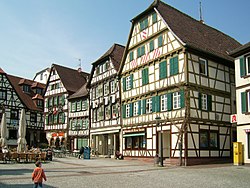Gölshausen
| Bretten | ||
|---|---|---|
 |
||
|
||
| Coordinates: 49°02′11″N 08°42′22″E / 49.03639°N 8.70611°ECoordinates: 49°02′11″N 08°42′22″E / 49.03639°N 8.70611°E | ||
| Country | Germany | |
| State | Baden-Württemberg | |
| Admin. region | Karlsruhe | |
| District | Karlsruhe | |
| Government | ||
| • Mayor | Martin Wolff | |
| Area | ||
| • Total | 71.12 km2 (27.46 sq mi) | |
| Elevation | 176 m (577 ft) | |
| Population (2015-12-31) | ||
| • Total | 28,826 | |
| • Density | 410/km2 (1,000/sq mi) | |
| Time zone | CET/CEST (UTC+1/+2) | |
| Postal codes | 75001–75015 | |
| Dialling codes | 07252 und 07258 | |
| Vehicle registration | KA | |
| Website | www.bretten.de | |
![]() Bretten (South Franconian: Bredde) is a town in the state of Baden-Württemberg, Germany. It is located on Bertha Benz Memorial Route.
Bretten (South Franconian: Bredde) is a town in the state of Baden-Württemberg, Germany. It is located on Bertha Benz Memorial Route.
Bretten lies in the centre of a rectangle that is formed by Heidelberg, Karlsruhe, Heilbronn and Stuttgart as corners. It has a population of approximately 28,000. The centre of Bretten consists of many old half-timbered houses around a lively marketplace. Towns and villages under the administration of Bretten include Bauerbach, Büchig, Diedelsheim, Dürrenbüchig, Gölshausen, Neibsheim, Rinklingen, Ruit and Sprantal.
Bretten was first mentioned as "villa breteheim" in the "Lorsch codex" in 767. Since 1148 Bretten had the right to mint and issue coins. In 1254 Bretten received city rights. In 1492 Bretten was granted to hold four fairs by Pfalzgraf Philipp. Philipp Melanchthon was born in Bretten in 1497. The residents of Bretten successfully sallied against the Swabian besiegers around Ulrich of Württemberg in 1504. In 1803 Bretten became “Badische Amtsstadt”. After the industrial revolution, the local economy was dominated by cooker production for many years. In 1975 Bretten was given the status of a "Große Kreisstadt" (district city).
...
Wikipedia


